About us
JAXA Aviation helps to create a safer and more prosperous society with aeronautics-related research and development activities.
FLIGHT PATH No.24 | 2019 WINTER
Challenges of Young Researchers Round table discussions in pursuit of the challenges set in the Fourth Mid-to-long-term Plan
Electric aircraft
ECLAIR consortium as a framework for interdisciplinary collaboration
-
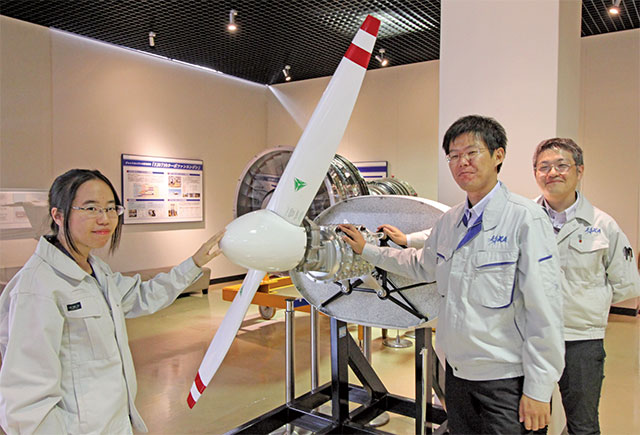
- JAXA has been working to develop emission-free aircraft technologies. Find some of our challenges toward electrification of aircraft, with focus on the Electrification Challenge for Aircraft (ECLAIR) consortium, in which we work in collaboration with various Japanese companies and organizations.
Nishiyama: I’m a researcher working on emission-free aircraft technologies at JAXA. For the ECLAIR consortium, I provide administrative support, such as coordination of meetings for launching technical committees and arranging logistics for open forums. Delivering the fruit of research to society is equally as important as doing the research itself, so I believe consortium activities are vital as they offer opportunities to connect with manufacturers that have the know-how to turn ideas into products and make them available to society. I get a lot of inspiration from sharing ideas with people who are active in different fields.
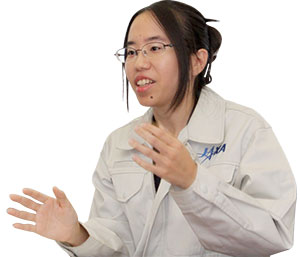
Researcher, Next Generation Aeronautical Innovation Hub Center
Iijima: I participated in last year’s first open forum as a student. Now that I’m on the organizing side, I’ve come to realize how hard it is to pull off something like this. Being a part of the consortium has reminded me that many fields are involved in making aircraft, which helps me further deepen my understanding on aeronautics.
Kobayashi: I’d like young researchers to cultivate a multifaceted perspective by interacting with people who work in different fields and different industries, as well as by spending time honing their expertise. Is there anything that surprised you in interacting with other fields?
Nishiyama: Aircraft flying at high altitudes are susceptible to the effects of radiation. I thought it was interesting that an electronics manufacturer was the first to focus on radiation protection.
Iijima: When motors and batteries were developed for use in automobiles and railway vehicles , the focus was on generating a lot of power with a body that’s compact enough to fit in their limited spaces. As for aircraft, while those aspects are important as well, greater focus is placed on weight reduction and reliability. I see a difference in perspectives there.
Nishiyama: Speaking of power output, I once heard from someone who worked for an automaker that cars never keep operating at maximum power. On the other hand, aircraft have to maintain maximum output during takeoff. Even though electric aircraft and cars both use motors, the focus is entirely different.
Iijima: Automobiles are more advanced in terms of putting a power electronics system into a small package. Also, trains and industrial equipment lead in technology to generate the large amounts of power needed in aircraft. Electrification of aircraft requires both, so I believe it’s a great target for aiming at the establishment of a new technology.
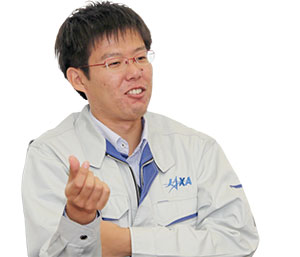
Researcher, Next Generation Aeronautical Innovation Hub Center
Electric aircraft as a catalyst for social change
Kobayashi: We see a lot of activities going on overseas particularly in connection with electric aircraft, but JAXA has steadily accumulated technology as well through FEATHER and other projects. We’ve finished sowing seeds, and now those seeds are ready to sprout.
Nishiyama: This year’s ECLAIR open forum 2019 saw presentations and discussions on more specific and advanced ideas of electrification challenges, based on its future vision presented in 2018.
Iijima: I feel that instead of just focusing on raising the level of technology, increasingly deeper discussions are being held based on ideas of implementation and reliability unique to aircraft. There are many electrical technologies that are not applied to aircraft yet. Working on those challenges that remain to be explored is also one of our goals, and something that makes all the effort worthwhile.
Nishiyama: Although demand for aircraft continues to grow, we have to curb CO2 emissions. If emission-free electric aircraft made an appearance amid these circumstances and started being operated just like any other aircraft, it would definitely be a game changer—and even change the world. There are many other things that can be enabled with electric aircraft, so I hope we can provide more information about them. It would be great if many technologies like that get implemented in society and contribute to a better world.
Iijima: Power electronics technology in transportation has been driven by automobiles and railway vehicles until now, but electric aircraft will take their place as the new leading edge. It would be exciting if our effort to push the boundaries of power electronics leads to a new technology, and that technology is applied to trains and automobiles, raising the level of technology overall while connecting all the different applications.
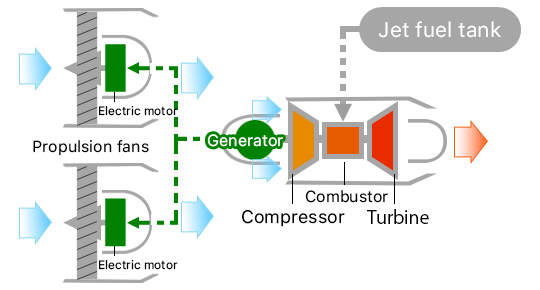

Principles of series hybrid propulsion. Electricity generated by a jet engine is supplied to electric motors to operate propulsion fans. Many of the electric aircraft currently being considered, including JAXA’s concept, adopt this system.
Nishiyama: As I meet all kinds of people, I hear more people bring up the topic of flying cars this year than last year. I feel that society’s interest is no longer limited to flying cars themselves but is growing to include aspects of air traffic control as well, and that people are starting to discuss the topic with a view to introducing them as a society.
Kobayashi: The ECLAIR consortium is a unique platform where members, who usually work as competitors, exchange ideas for electrification of aircraft. While each member has a different reason for participating, I believe we are pretty close to laying a foundation for working in alignment to realize electric aircraft. JAXA, myself included, should continue to play a leading role in the effort to develop Japanese-made electric aircraft.
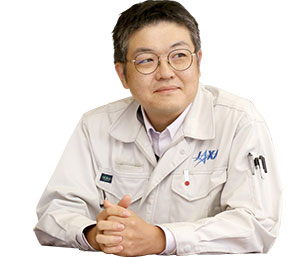
Associate Senior Researcher, Next Generation Aeronautical Innovation Hub Center
“Electric aircraft technology doesn’t have any established research system yet, and there’s very little data obtained with actual aircraft. Playing a lead role in these efforts is what is expected of JAXA by the Japanese industry, which is challenging but rewarding, I think. More and more people even outside JAXA are joining the effort to cooperate. Let’s all rack our brains and move forward together.”
NISHIZAWA Akira
Director, Next Generation Aeronautical Innovation Hub Center